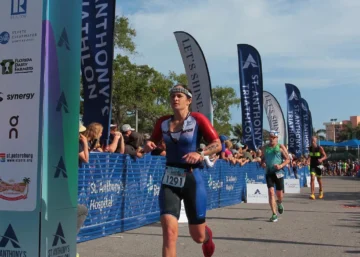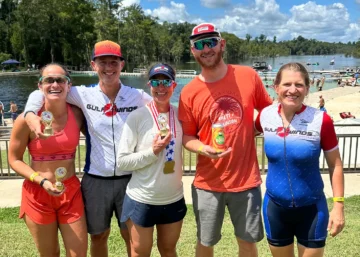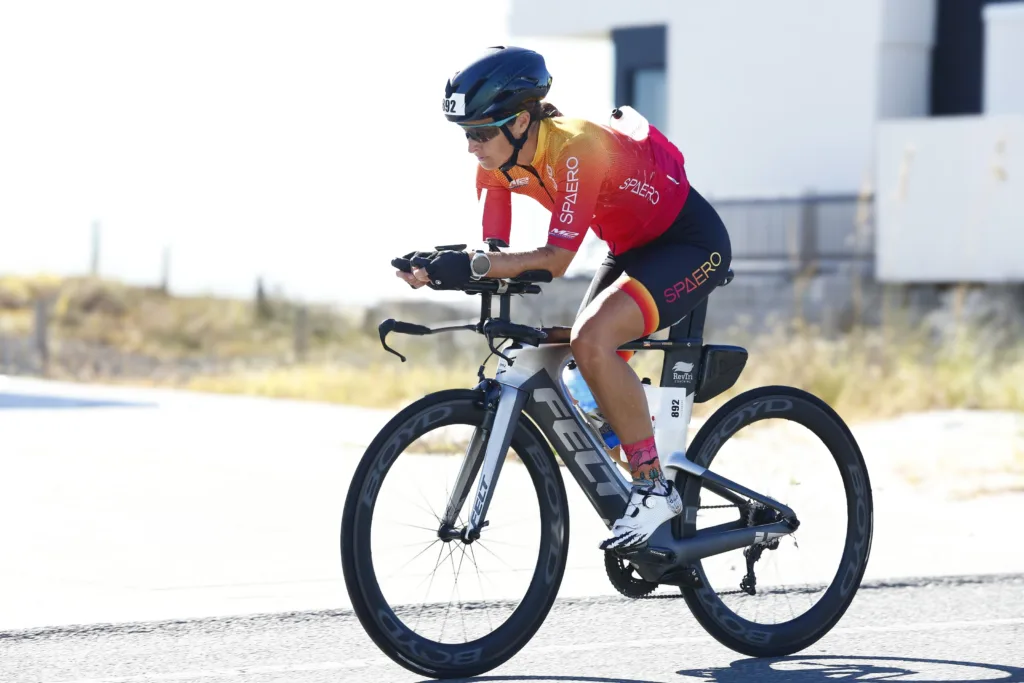
Yes, you read that right. I did an Ironman, specifically Ironman Florida just a couple of months ago, and didn’t use a single aid station.
How? And more importantly, why?
For the answers to those questions, first you need a bit of background about me, as a triathlete.
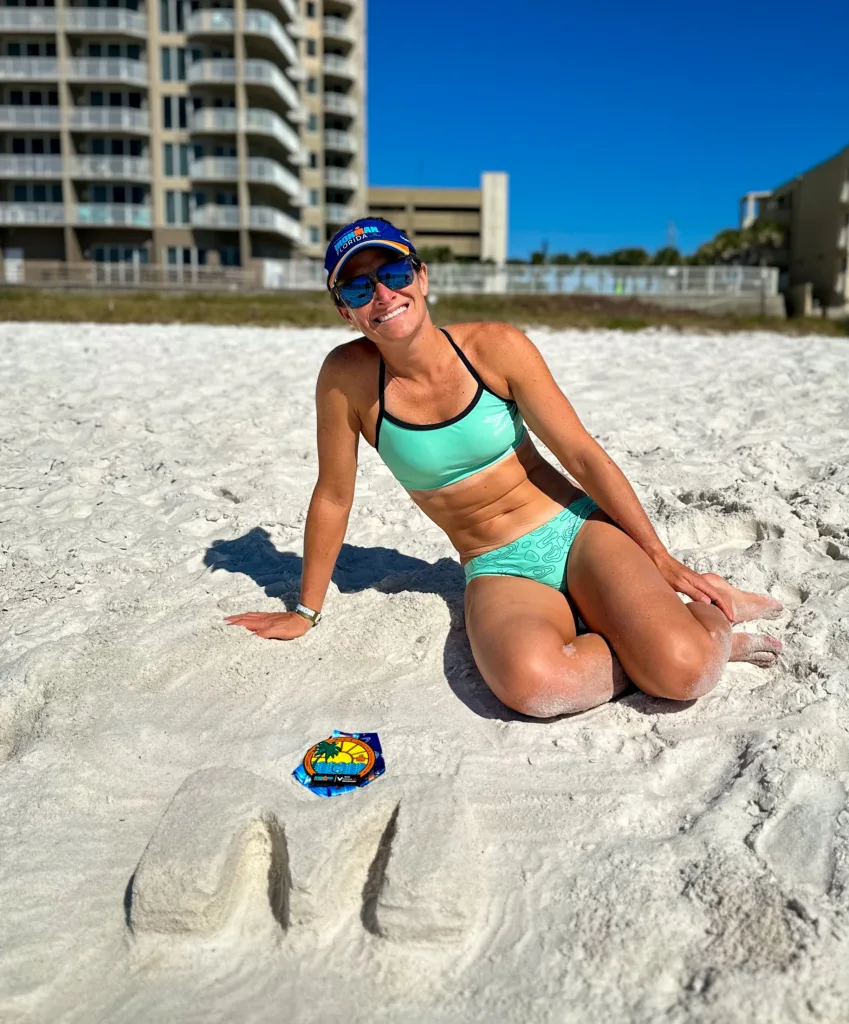
I did my first triathlon, a local super sprint, in 2019. I had a great time and even won the female division, but I think the thing I enjoyed most was the aspect of competing against yourself, and the clock.
I’ve been an athlete my whole life (softball, tennis, karate, soccer, cheerleading, equestrian, ect.) but this was the first sport that didn’t rely on a team, a partner, and didn’t have a judged component. In triathlon, it doesn’t matter what anyone thinks of your performance; it’s a race against the clock, and yourself, and that’s a mindset I’ve maintained to this day.
After my first triathlon, I progressed to sprint triathlons, duathlons, Olympics, and eventually did my first 70.3 alongside my husband (his first 70.3 as well) at Chattanooga in 2021. Since then, I’ve done the 70.3 World Championship in St. George, 70.3 North Carolina, 70.3 Augusta, and 70.3 Chattanooga two more times, for a grand total of 6 half Ironmans.
In 2023, I decided I wanted to do my first Ironman, and because we live in Florida, a race two hours down the road in Panama City fit the bill nicely. I got a PR in the swim, the bike, and ran my first marathon, so I was pretty pleased with the result, but most importantly I had a great time!
And I didn’t use a single aid station.
To be completely transparent, I did stop at aid stations to get water and ice (I’m not a camel) but I didn’t use any on-course nutrition. When I tell people that, they’re always pretty surprised.
“How do you carry it all?”
“Why do you bring your own nutrition?”
“Why not use what they have on course?”
I’m happy to answer all of those questions and more, especially if it might help someone else prepare for their first full distance race. But, honestly, it’s really common. More athletes these days are carrying their own nutrition during races. Everyone has their own reasons. Here’s mine.
I want to be able to control the exact formula and concentration of my nutrition. I learned the hard way that even if you’re training with the same brand of nutrition that will be used on course, it might be mixed differently than you’re used to, which can cause big problems…
Case in point, during my early triathlon career, I used Gatorade Endurance. It made sense because it was available on course and easily accessible for training purposes. But, the Gatorade Endurance that you use during training is likely different than what you use on course. Why? Most athletes purchase Gatorade Endurance in powder form, so you have to mix it per their specifications to get the carb count right: 1 1/2 scoops for 12 fl. oz and 3 scoops for 24 fl oz.
But if you’re on a bike course, you will pick up a Gatorade Endurance, pre-mixed 24 oz. bottle. In contrast, on the run course, you will pick up a small paper cup that’s filled with a mix made from the powder. 16 scoops of GE makes 1 gallon with the same formulation as what you drink at home. Maybe. It’s all dependent on how the volunteers mix it…
That’s the first issue, but the second is that the ingredients for the powder and pre-mixed bottle are slightly different.
Gatorade Endurance bottle- water, sugar, maltodextrin, fructose, citric acid, sodium citrate, monopotassium phosphate, salt, natural flavor, calcium lactate, ascorbic acid, magnesium oxide, and beta carotene
HAS- ascorbic acid
Gatorade Endurance powder- sugar, maltodextrin, fructose, citric acid, sodium citrate, monopotassium phosphate, salt, natural flavor, calcium lactate, magnesium oxide, beta carotene, calcium silicate, gum arabic, and sodium ascorbate.
HAS- Gum arabic, sodium ascorbate, calcium silicate
I’m not a nutritionist, so I won’t get into what each ingredient does, but suffice to say, I can tolerate the powder, but I don’t tolerate the pre-mixed bottle. I learned that the hard way with some pretty intense vomiting around mile 8 of a 70.3 and it cost me a pretty big PR.
That’s the main reason why I carry my own nutrition for races. I want to use the exact formulation I use in training.
I don’t rely on on course nutrition at any race, regardless of distance. It’s a particularly timely topic this week as there’s a lot of speculation surrounding what nutrition will be on course at certain upcoming races… I can’t speak to that. The official details will be coming out soon, but it’s a good reminder that, as athletes, we’re always responsible for our own nutrition.
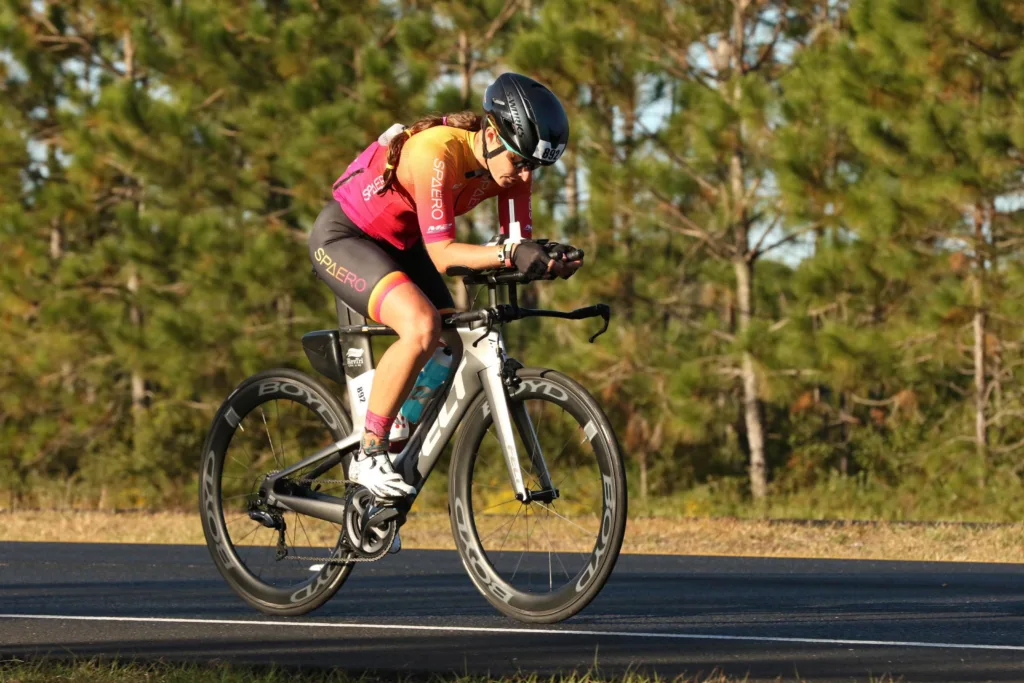
Honestly, carrying your own nutrition is something a lot of athletes do these days. It’s not that hard; it just takes some planning.
For a 70.3, I plan to be on the bike for just under 3 hours, so I will need at least five 24 oz. bottles. Last year, I used Maurten. I had my 3 bottles of carb mix, and then I picked up 2 bottles of water on course. That meant I had my carb mix in my aero bottle and two bottles in my bottle cages.
For an Ironman with a 112-mile bike ride and a 26.2-mile run, it takes a bit more planning. I was on the bike for 6:06, but during an Ironman, there’s a special needs station located at the halfway point. So, I used my same 70.3 system of 3 bottles of carb mix and 2 water bottles for the first half of the bike. Then, at special needs, I had 3 new carb bottles waiting. I ended up only using 2, but I always like to have extra, just in case I drop one.
If you’re an athlete who takes gels or salt, you can keep that in the top tube of your bike or a run belt. All of my carbs and salt are in my bottles, so I don’t need to carry anything extra.
Yes, another shocking thing… I didn’t take any gels during my Ironman. All my carbs are in my bottles. It’s whatever works for you, but don’t feel like you have to eat 12 gels or 2 peanut butter and jelly sandwiches just because you’ve seen someone else do it…
Tip: To keep track of nutrition, I write my hourly plan on a sticky note and use clear packing tape to affix it to my top tube, just under my aero bars. That way I know exactly when I need to be done with each bottle to stay on track.

For the run, I switched to a lower carb mix, Skratch Clear. I used two, 10 oz. bottles in my run belt, and I had a few single-serve packets that I could drop in and add water to at aid stations. At the special needs section of the run, I discarded the empty bottles, picked up two, pre-made bottles I had waiting, and continued the process.
I didn’t figure this out all on my own. My coach has a background in nutrition, and I’ve worked with a sport nutritionist in the past as well, so I know exactly what I’m supposed to take and what works for me. It’s a trial and error process, but it helps if you have guidance from someone who will help you sift through the numbers and provide good recommendations for where you’re at in your triathlon career.
That’s another thing people don’t often consider. Your nutritional needs might change as your fitness level does. SAY WHAT?! It’s true. The nutrition plan I used when I first started doing triathlon isn’t the same as it is now. The human body changes, and your capacity to train/race at a higher intensity might affect the type of nutrition you use.
Tip: Find what works for YOU. Just because you see a random guy on Instagram who says he uses 90 carbs an hour during his Ironman, that doesn’t mean you should. Nutrition is individual, specific, and can vary based on fitness level, age, gender, ect.

So that’s how I did an Ironman without using a single aid station. Is it something you can do too? Absolutely. Do you have to? Certainly not.
There’s nothing wrong with using on-course nutrition if it works for you. I like to be in complete control over what I take in during a race, so I carry my own nutrition.
This year, I’ll be using Never Second. It’s a very light flavored endurance sport drink with only FOUR ingredients: maltodextrin, fructose, natural flavor, and sodium. It has a 2:1 maltodextrin to fructose mix and a neutral pH, so it’s easy on my stomach. I also like that it’s personalizable by scoop, so 1 scoop is 30 grams of carbs and 200 mg sodium, 2 scoops would be 60 grams of carbs and 400 mg sodium, ect.
If you’d like to try it out, you can use code: AMBASSADORREF15 for 15% off, but it only works for the first 20 athletes who use it.
